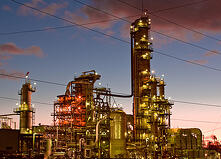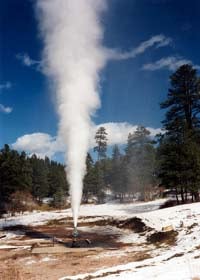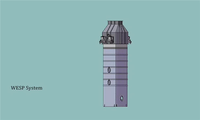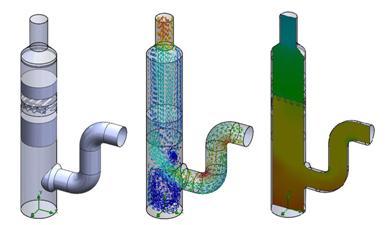There are several industrial processes that face the challenge of meeting increasingly aggressive metals emission standards. In many cases these standards exceed the capability of existing air pollution control equipment which can include bag-houses and packed bed absorbers. Some of these processes include:
Some of the metals of concern can include mercury, arsenic, lead, cadmium, nickel and others, depending on the process. To achieve more stringent metals emission standards, three features should be designed into the air pollution control system.
 Removal of the bulk particulate load - Removal of the bulk particulate load may be required if there is a high particulate concentration from the upstream process. This will be the case for secondary lead smelters, lead refining, and refinery sludge incinerators. Geothermal energy plants will not have this requirement. A bag-house will be used for secondary lead smelters and lead refining. A wet Venturi scrubber system can be used for refinery sludge incinerators Removal of the bulk particulate minimizes space-charge effects inside the WESP. Space-charge effects occur when particles interact and repel each other. This reduces WESP performance because it interferes with the migration of charged particle to the tube wall for collection.
Removal of the bulk particulate load - Removal of the bulk particulate load may be required if there is a high particulate concentration from the upstream process. This will be the case for secondary lead smelters, lead refining, and refinery sludge incinerators. Geothermal energy plants will not have this requirement. A bag-house will be used for secondary lead smelters and lead refining. A wet Venturi scrubber system can be used for refinery sludge incinerators Removal of the bulk particulate minimizes space-charge effects inside the WESP. Space-charge effects occur when particles interact and repel each other. This reduces WESP performance because it interferes with the migration of charged particle to the tube wall for collection.
Sub-cooling the gas - Some of the volatile metals may be in the vapor phase when they pass through a bag-house at higher temperature. In this case they will pass right through the bag-house and will not be collected. Sub-cooling the gas is done after the bag-house and uses a condenser/absorber to cool the gas below the saturation temperature. Sub-cooling is beneficial because it condenses as much of the volatile metals as possible so they can later be removed as particulate. In the case where a Venturi is used to remove bulk particulate, like for a refinery sludge incinerator, it has the added benefit of condensing water onto the particulate and condensed metals. This increases their diameter making them easier to remove in a Venturi scrubber. Sub-cooling also reduces the gas volume, which helps to reduce the size and cost of a downstream WESP.
Wet Electrostatic Precipitator (WESP) for polishing - A wet electrostatic precipitator is used as a final particulate polishing stage. The performance is relatively independent of the particle size so it is highly effective at sub-micron particulate control. In some cases, a condenser/absorber (C/A) for sub-cooling can be integrated into the conditioning section of an upflow WESP. This was successfully done at a secondary lead smelter downstream of bag-house. The C/A was also used to neutralize SO2 in the gas stream. The integrated C/A and WESP achieved > 98% removal of arsenic and > 92% removal of lead and other condensed metals after the bag-house. This substantially reduced the plants cancer risk index and helped to meet more stringent fence line lead emission standards.
To download a free white paper on wet electrostatic precipitator for a secondary lead smelter, click the link below.


To view a free wet electrostatic precipitator video, click on the link below.


Geothermal by Louis Falcon
Refinery by Szeke
 April 8-10, 2013. We will exhibit at Booth 807. During the conference I will be presenting in the Pellets & Densified Biomass track between 8:30 am and 10:00 on Wednesday, April 10th. The topic will be "High Performance Wet Electrostatic Precipitator (WESP) for Pellet Mills".
April 8-10, 2013. We will exhibit at Booth 807. During the conference I will be presenting in the Pellets & Densified Biomass track between 8:30 am and 10:00 on Wednesday, April 10th. The topic will be "High Performance Wet Electrostatic Precipitator (WESP) for Pellet Mills".  These mills use wood dryers to remove moisture from incoming feed material. A wet electrostatic precipitator (WESP) collects particulate (PM) and condensed volatile organic compounds (VOC) from the dryer exhaust. This is required to protect a downstream regenerative thermal oxidizer (RTO) from fouling. The RTO destroys volatile organic compounds (VOCs) before exhausting to the atmosphere. The process flow conditions are large and typically several hundred thousand cubic feet per minute.
These mills use wood dryers to remove moisture from incoming feed material. A wet electrostatic precipitator (WESP) collects particulate (PM) and condensed volatile organic compounds (VOC) from the dryer exhaust. This is required to protect a downstream regenerative thermal oxidizer (RTO) from fouling. The RTO destroys volatile organic compounds (VOCs) before exhausting to the atmosphere. The process flow conditions are large and typically several hundred thousand cubic feet per minute.


 from used automobile batteries. The process uses a combination of combustion processes including kilns and furnaces. Despite extensive control equipment including bag-houses, HEPA filters, and wet scrubbers, low concentrations of heavy metals were being emitted from various stack sources. Cancer risk index standards were being exceeded due to the close proximity of residents to the plant. To be compliant with state regulations a solution was needed to reduce these emissions. The special circumstances of nearby residents and a stringent cancer risk index required the facility to meet emission limits well below any other secondary lead smelter in the country.
from used automobile batteries. The process uses a combination of combustion processes including kilns and furnaces. Despite extensive control equipment including bag-houses, HEPA filters, and wet scrubbers, low concentrations of heavy metals were being emitted from various stack sources. Cancer risk index standards were being exceeded due to the close proximity of residents to the plant. To be compliant with state regulations a solution was needed to reduce these emissions. The special circumstances of nearby residents and a stringent cancer risk index required the facility to meet emission limits well below any other secondary lead smelter in the country. 
 is upgrading a sulfite pulping mill in Eastern Canada to incorporate a new red liquor recovery boiler for power generation. The boiler system increases annual green energy production by up to 40-megawatts, reduces sulfur dioxide emissions by 70%, and increases annual production capacity of specialty cellulose by 5,000 metric tonnes. The off-gas from the recovery boiler contains a high concentration of SO2 which needs to be recovered for re-use in the production process.
is upgrading a sulfite pulping mill in Eastern Canada to incorporate a new red liquor recovery boiler for power generation. The boiler system increases annual green energy production by up to 40-megawatts, reduces sulfur dioxide emissions by 70%, and increases annual production capacity of specialty cellulose by 5,000 metric tonnes. The off-gas from the recovery boiler contains a high concentration of SO2 which needs to be recovered for re-use in the production process. 



 high as 98% and 99% and reductions of lead from 615 lb/yr to 1.22 lb/hr. The facility is now achieving emissions that are several orders of magnitude lower than other secondary lead smelters.
high as 98% and 99% and reductions of lead from 615 lb/yr to 1.22 lb/hr. The facility is now achieving emissions that are several orders of magnitude lower than other secondary lead smelters.
 HEPA filters, and wet scrubbers. Because residential neighborhoods had moved closer to the boundaries of the plant over the years, the stack emission limits were insufficient to meet the cancer risk index. In other words, the facility had to achieve lower emission levels than other similar plants. The WESP system was installed in 2007 and provided a performance guarantee for arsenic, lead, and nickel which were the larger contributors to the cancer risk index.
HEPA filters, and wet scrubbers. Because residential neighborhoods had moved closer to the boundaries of the plant over the years, the stack emission limits were insufficient to meet the cancer risk index. In other words, the facility had to achieve lower emission levels than other similar plants. The WESP system was installed in 2007 and provided a performance guarantee for arsenic, lead, and nickel which were the larger contributors to the cancer risk index.


 Removal of the bulk particulate load - Removal of the bulk particulate load may be required if there is a high particulate concentration from the upstream process. This will be the case for secondary lead smelters, lead refining, and refinery sludge incinerators. Geothermal energy plants will not have this requirement. A bag-house will be used for secondary lead smelters and lead refining. A wet Venturi scrubber system can be used for refinery sludge incinerators Removal of the bulk particulate minimizes space-charge effects inside the WESP. Space-charge effects occur when particles interact and repel each other. This reduces WESP performance because it interferes with the migration of charged particle to the tube wall for collection.
Removal of the bulk particulate load - Removal of the bulk particulate load may be required if there is a high particulate concentration from the upstream process. This will be the case for secondary lead smelters, lead refining, and refinery sludge incinerators. Geothermal energy plants will not have this requirement. A bag-house will be used for secondary lead smelters and lead refining. A wet Venturi scrubber system can be used for refinery sludge incinerators Removal of the bulk particulate minimizes space-charge effects inside the WESP. Space-charge effects occur when particles interact and repel each other. This reduces WESP performance because it interferes with the migration of charged particle to the tube wall for collection.



